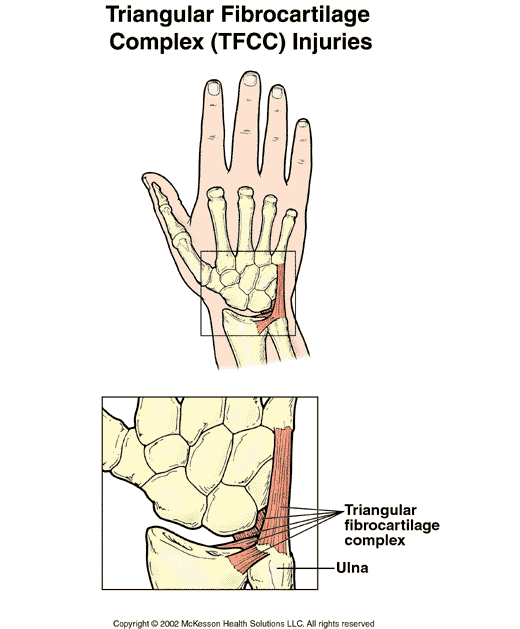The X-ray below depicts a person’s left hand (from above), and shows how the TFCC resides on the “ulnar side” (the outside) of the wrist…

I’ve been learning about a new body part over the last 3 months. It’s called the Triangular Fibrocartilage (TFC), and is part of a larger grouping of anatomy in the wrist, called the Triangular Fibrocartilage Complex (TFCC). The TFCC consists of several ligaments as well as cartilage arranged in a triangular shape. The TFCC stabilizes the bones of the wrist, joins the ulna and the radius, separates these same bones from the carpal bones (the base of the palm), and functions as a shock absorber for impacts to the hand and arm. Until my 55th year, I knew nothing of this intricate piece of anatomy. But when the TFCC starts protesting, it will be heard.

The picture to the right shows (in blue), the various
parts of the TFCC (of the wrist of the left hand). And it specifically calls out the TFC, which is at the bottom of the TFCC, where it
attaches the ulna and the radius.
Swimmers are often concerned about the wear and tear that
they are putting on their shoulders, and rotator cuff problems can be the darkest fear of swimmers, pitchers, and tennis players. But hey, the TFCC deserves some attention, too.
Last October I was swimming long course, splitting the lane with someone, I know not who. As we approached each other our left hands collided, and my hand was bent down and out (towards the outside of my arm–towards the ulna). It hurt at the time, and continued hurting for about a week, but then the pain subsided. October to December is my slack time in the pool, so I was not really over-exerting my wrists. Come January, the goal of swimming across Lake Siljan sprung to life, and my yardage jumped up significantly. Within a week my left wrist had swollen up, and was painful. It was evident that the light injury I’d sustained to my wrist in October was making itself known.
The TFCC on my left hand had swollen up quite a bit, and it was painful when I swam. I iced my left wrist after my longer workouts, and I was feeling very protective of my left wrist when I was sharing a lane with one or more hoopleheads (e.g. non-swimmers and/or recreational swimmers). I went to a physical therapist for a while, and I got some advice from a local chiropractor also. Eventually I went to see an orthopedic surgeon who specializes in the hands and wrists. He examined my hand, and he had a couple of X-rays taken. The X-rays indicated that there was no obvious contributing factor to my problem (like a “burr” on the end of the ulna for instance). The doc’s feeling was that I did not have a problem with any of the ligaments associated with the TFCC, but rather there was a small tear in the cartilage where it attaches to the ulna.
The doctor indicated that an MRI could tell us more about the nature of the cartilage tear. (I declined.) He further indicated that a long-term solution would involve me not swimming for 2-3 months (I took this to mean he was suggesting surgery, but I am not sure if that is what he meant. Personally I’d never go in for surgery unless I exhausted every other treatment and was desperate for a “last ditch” effort.) The doctor also said that use of the wrist was not going to further damage the TFC, and that I was free to “swim away”. He noted that a squirt of cortisone in my wrist was an option to reduce inflammation (which was now the permanent condition of my wrist). I opted for this treatment, taking a couple of blasts of cortisone from a hypodermic needle. I wish I had a picture of this, because a needle in a wrist seems very unnatural. But I was busily averting my eyes while he gave me the shots, and wasn’t thinking about documenting the shots when they were being given.
So, what ensued was a full day of an oddly swollen left wrist, and increased pain. Then the swelling and pain subsided, and for the last fourteen days I have been pain-free, and am no longer aware of my wrist. I have a greater appreciation for a previously-unknown-by-me part of my body that is a necessary contributor to pulling myself across Lake Siljan in July. Also, I am doing exercises with a device (suggested by local chiropractor Sandy Sachs) called a DFX Powerball, to strengthen my hand, wrist, and forearm. Read more here.
Here’s one last image of the TFCC:
So, at this point I am thinking that I may have dodged a bullet; I’m paying attention to my wrists in any case; training is going forward as planned.
END

